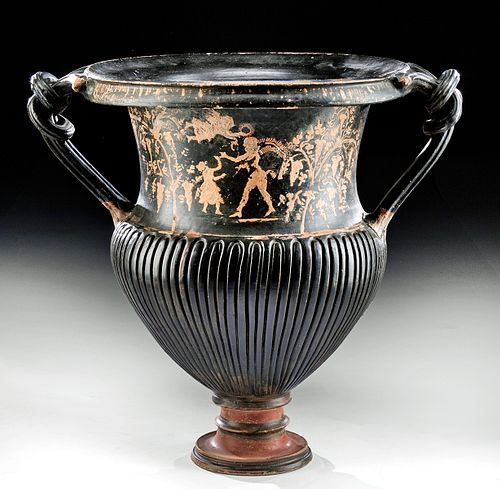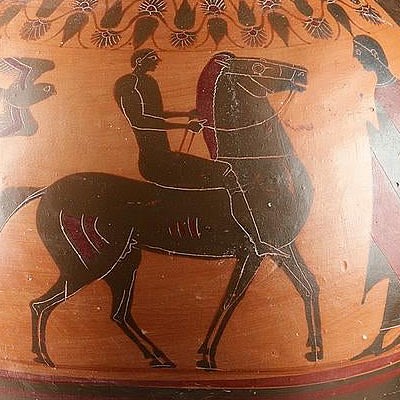Huge / Published Gnathian Pottery Vessel - Nike, Maenad
Lot 24a
About Seller
Artemis Fine Arts
686 S Taylor Ave, Ste 106
Louisville, CO 80027
United States
Selling antiquities, ancient and ethnographic art online since 1993, Artemis Gallery specializes in Classical Antiquities (Egyptian, Greek, Roman, Near Eastern), Asian, Pre-Columbian, African / Tribal / Oceanographic art. Our extensive inventory includes pottery, stone, metal, wood, glass and textil...Read more
Categories
Estimate:
$18,000 - $25,000
Absentee vs Live bid
Two ways to bid:
- Leave a max absentee bid and the platform will bid on your behalf up to your maximum bid during the live auction.
- Bid live during the auction and your bids will be submitted real-time to the auctioneer.
Bid Increments
| Price | Bid Increment |
|---|---|
| $0 | $25 |
| $300 | $50 |
| $1,000 | $100 |
| $2,000 | $250 |
| $5,000 | $500 |
| $10,000 | $1,000 |
| $20,000 | $2,500 |
| $50,000 | $5,000 |
| $100,000 | $10,000 |
| $200,000 | $20,000 |
About Auction
By Artemis Fine Arts
Jun 4, 2020
Set Reminder
2020-06-04 10:00:00
2020-06-04 10:00:00
America/New_York
Bidsquare
Bidsquare : Exceptional Antiquities, Asian, Ethnographic
https://www.bidsquare.com/auctions/artemis-gallery/exceptional-antiquities-asian-ethnographic-5185
An important one-day auction featuring museum-worthy examples of Egyptian, Greek, Roman, Etruscan, Near Eastern, Far East / Asian, Pre-Columbian, African / Tribal, Oceanic, Native American, Spanish Colonial, Russian, Fossils, Ancient Jewelry, Fine Art, so much more! Artemis Fine Arts info@artemisgallery.com
An important one-day auction featuring museum-worthy examples of Egyptian, Greek, Roman, Etruscan, Near Eastern, Far East / Asian, Pre-Columbian, African / Tribal, Oceanic, Native American, Spanish Colonial, Russian, Fossils, Ancient Jewelry, Fine Art, so much more! Artemis Fine Arts info@artemisgallery.com
- Lot Description
Magna Graecia, Southern Italy, Gnathia, ca. 300 to 270 BCE. A huge Gnathian amphora with a beautifully ribbed body, a gently curved neck presenting (on Side A) a red-figure scene featuring a Satyr striding left toward a petite Maenad with a winged Nike carrying an ivy victory wreath - all flanked by flourishing grapevines and on the opposite side (Side B) - additional grapevines (possibly laurel leaf vines), rising to a tiered rim adorned by a band of ovalo, twin substantive Herakles (Heracles or Hercules) knot handles with petite maskettes at each terminal of the upper ends. Size: 20.5" W handlespan x 19.125" H (52.1 cm x 48.6 cm)
According to the British Museum, "The marriage-knot or knot of Hercules, a strong knot created by two intertwined ropes, originated as a healing charm in ancient Egypt, but is best known for its use in ancient Greece and Rome as a protective amulet, most notably as a wedding symbol. The symbolism of the knot survived well beyond its religious use, and was a common symbol in medieval and Renaissance love tokens." In addition, according to Roman historian Pliny, the Herakles knot had the ability to cure wounds.
Published in Collection Le Vin (Vases a Melanger - Crateres) - La Reine Margot Paris, 2006 , p. 83 - for a special exhibition with a theme revolving around wine.
Provenance: private Orange County, California, USA collection; ex private East Coast, USA collection; ex-La Reine Margot, a third generation antiquities dealer in Paris, France; Published in Collection Le Vin (Vases a Melanger - Crateres) - La Reine Margot Paris, 2006 , p. 83 - for a special exhibition with a theme revolving around wine.
All items legal to buy/sell under U.S. Statute covering cultural patrimony Code 2600, CHAPTER 14, and are guaranteed to be as described or your money back.
A Certificate of Authenticity will accompany all winning bids.
We ship worldwide and handle all shipping in-house for your convenience.
#155865One side of rim and upper body of vessel has been expertly repaired and restored, as has the foot. This includes some overpainting in the style of the original motifs and reattachment of handle. Light deposits on surface.Condition
- Shipping Info
-
All shipping is handled in-house for your convenience. Your invoice from Artemis Gallery will include shipping calculation instructions. If in doubt, please inquire BEFORE bidding for estimated shipping costs for individual items.
-
- Buyer's Premium



 EUR
EUR CAD
CAD AUD
AUD GBP
GBP MXN
MXN HKD
HKD CNY
CNY MYR
MYR SEK
SEK SGD
SGD CHF
CHF THB
THB
















